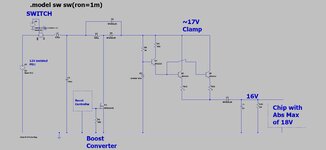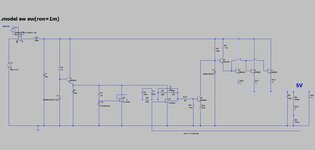cupoftea
Advanced Member level 5
Hi,
Have a 12V supply which will get suddenly switched into a connector…..where it will ring like billy-o with an input LC filter….there’s then a 12V to 16V Boost converter, and then a Gate Drive IC with 18V Abs Max. (The Gate drive IC will draw some 300mA, as its feeding a gate drive transformer)
The Abs Max is going to get violated so we need to interpose a ~17V clamp at the VCC input to the Gate Drive IC. We want it to dissipate as little as possible, and use as few components as poss…..can you think of a better way than the attached?
LTspice and jpeg schem attached
Have a 12V supply which will get suddenly switched into a connector…..where it will ring like billy-o with an input LC filter….there’s then a 12V to 16V Boost converter, and then a Gate Drive IC with 18V Abs Max. (The Gate drive IC will draw some 300mA, as its feeding a gate drive transformer)
The Abs Max is going to get violated so we need to interpose a ~17V clamp at the VCC input to the Gate Drive IC. We want it to dissipate as little as possible, and use as few components as poss…..can you think of a better way than the attached?
LTspice and jpeg schem attached

